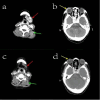Mikulicz's disease combined with IgG4-related hypophysitis: a case report
- PMID: 38880897
- PMCID: PMC11181676
- DOI: 10.1186/s12877-024-05142-7
Mikulicz's disease combined with IgG4-related hypophysitis: a case report
Abstract
Background: IgG4-related diseases are very uncommon, and its diagnosis and treatment are complicated as it encompasses multiple disciplines.
Case presentation: A 77-year-old woman was admitted with a jaw mass and nausea and vomiting. Laboratory tests showed elevated serum IgG4, pituitary MRI suggested thickening of the pituitary stalk, and head and neck CT suggested orbital and mandibular masses. Patients with mandibular mass were diagnosed with Mikulicz's disease with IgG4-related hypophysitis. We found no other evidence of causing thickening of the pituitary stalk. She was given oral prednisolone 30 mg daily, and her nausea and vomiting improved significantly, and the mandibular and ocular masses decreased in size.
Conclusion: Mikulicz's disease combined with IgG4-related hypophysitis is a rare case of IgG4-RD in elderly women. IgG4-RD is one of the causes of head and neck exocrine gland mass and pituitary stalk thickening in the elderly.
Keywords: Case report; IgG4-related disease; IgG4-related hypophysitis; Mikulicz’s disease; Pituitary stalk.
© 2024. The Author(s).
Conflict of interest statement
The Authors declare they have no competing interests.
Figures




Similar articles
-
Mikulicz's Disease with hypophysitis - a new IgG4-mediated disorder.Endokrynol Pol. 2016;67(6):622-626. doi: 10.5603/EP.2016.0071. Endokrynol Pol. 2016. PMID: 28042654
-
A case of Mikulicz's disease complicated with severe interstitial nephritis associated with IgG4.Clin Exp Nephrol. 2009 Aug;13(4):367-372. doi: 10.1007/s10157-008-0127-5. Epub 2009 Jan 14. Clin Exp Nephrol. 2009. PMID: 19142575
-
Pediatric IgG4-related dacryoadenitis and sialadenitis (Mikulicz's disease) with acquired hemophilia A: A case report and review of literature.Int J Immunopathol Pharmacol. 2024 Jan-Dec;38:3946320241301734. doi: 10.1177/03946320241301734. Int J Immunopathol Pharmacol. 2024. PMID: 39605254 Free PMC article. Review.
-
A case of Mikulicz's disease, IgG4-related plasmacytic syndrome, successfully treated by corticosteroid and mizoribine, followed by mizoribine alone.Intern Med. 2010;49(14):1449-53. doi: 10.2169/internalmedicine.49.3101. Epub 2010 Jul 15. Intern Med. 2010. PMID: 20647666
-
[The significance of disease-independence in Mikulicz's disease--revival interests in Mikulicz's disease].Nihon Rinsho Meneki Gakkai Kaishi. 2006 Feb;29(1):1-7. doi: 10.2177/jsci.29.1. Nihon Rinsho Meneki Gakkai Kaishi. 2006. PMID: 16505597 Review. Japanese.
References
Publication types
MeSH terms
Substances
LinkOut - more resources
Full Text Sources
Miscellaneous

